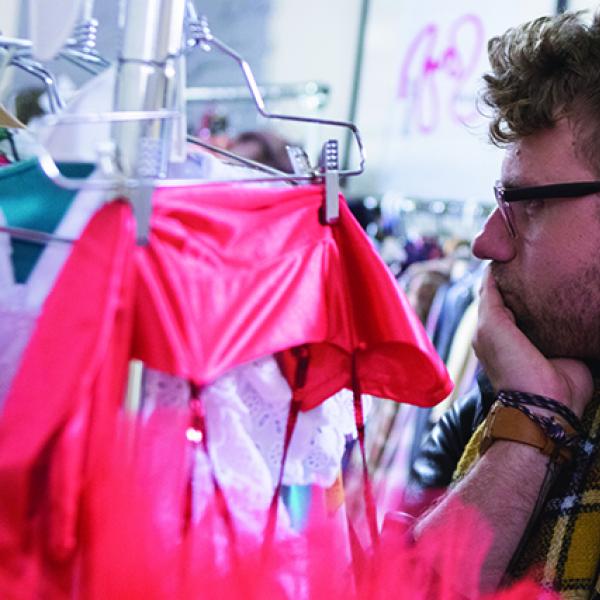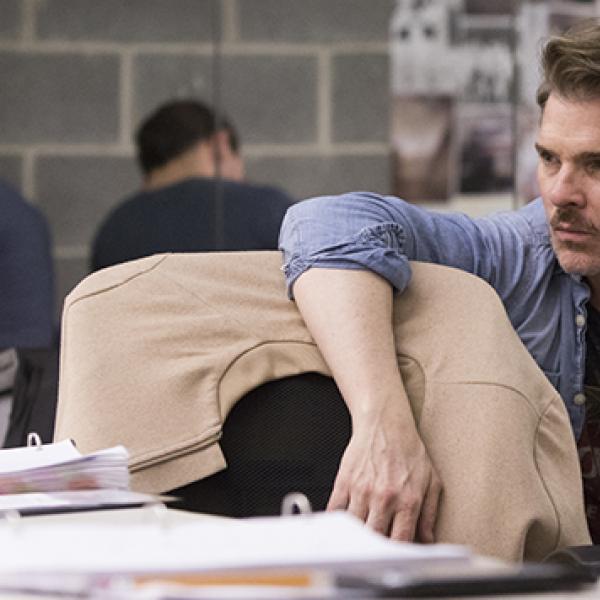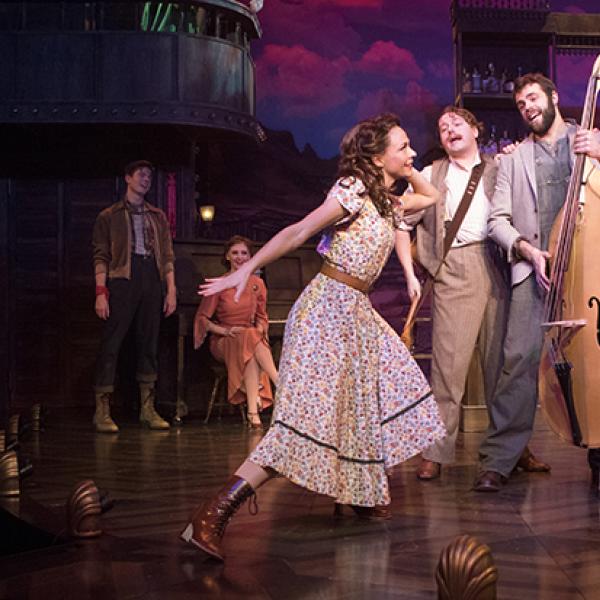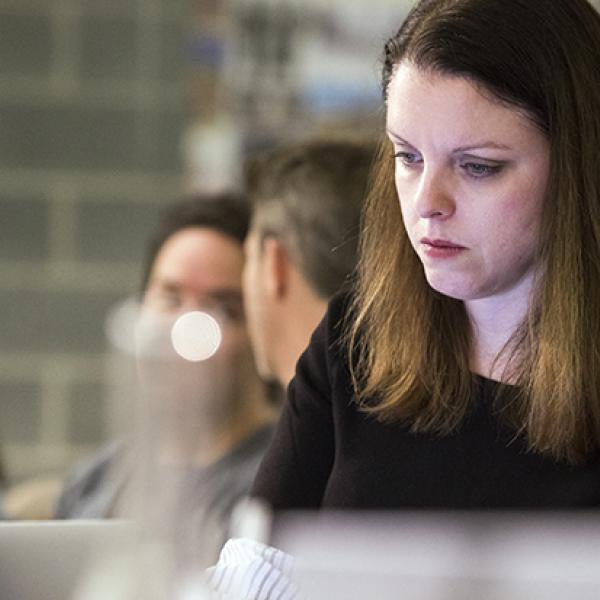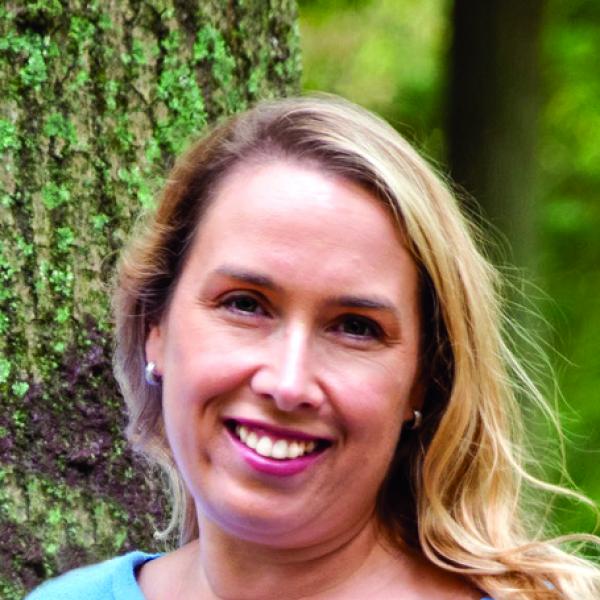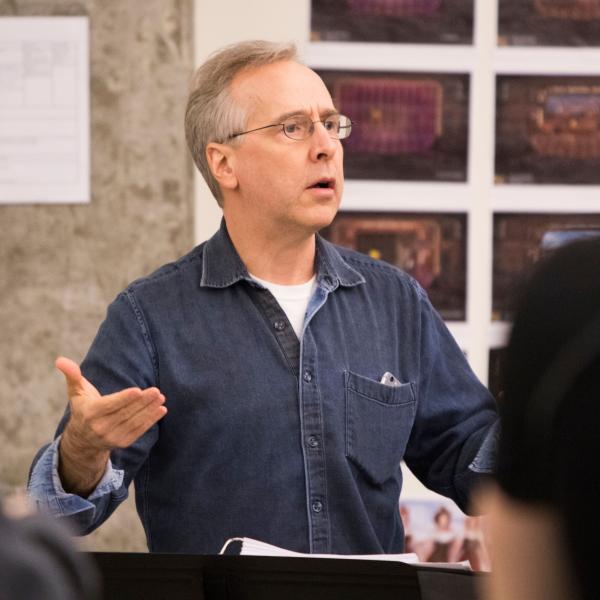Sound Designer Ryan Hickey: Listening as an Art Form
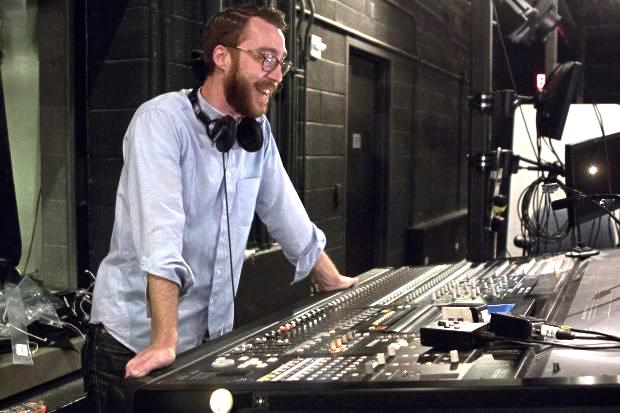
Sound Designer Ryan Hickey. Photo by Christopher Mueller
While sound has always been an integral part of theater, sound design is relatively new as a distinct craft. And just to complicate things, sound designers often wear two hats. For “straight” plays, they work with the director to create the right sound for the play—which can mean content building, such as composing incidental music, creating sound effects and sound beds. For musical theater, on the other hand, the sound designer’s main job is to create sound systems that allow the music, the singing, and the dialogue to be heard uniformly and organically throughout the theater. As Ryan Hickey, sound designer for Signature Theatre’s production of Crazy for You, says, “the goal is to get the sound system to disappear,” which is no small feat—given the play requires more than 300 cables, 36 channels of wireless microphones on the stage, 48 microphones for the orchestra, 12 channels of sound effects, and more than 20 speakers. Hickey tells us how he does it and takes us through the steps of constructing systems for sound that make the amplification inconspicuous.
Ryan Hickey: There’s a lot of copper in the room. We have 36 channels of wireless microphones. We have close to 48 microphones in the pit, and then 12 channels of sound effects
Jo Reed: That is the sound designer for Signature theatre Ryan Hickey and this is NEA Arts online. I’m Josephine Reed.
The recent issue of NEA Arts goes behind the scenes of Signature Theatre’s production of Crazy for You®. With music and lyrics by George and Ira Gershwin and book by Ken Ludwig, the 1992 Tony Award winner is old-fashioned musical theater at its best. We wanted to speak with the people working behind the curtain—the backstage workers who never take a bow and yet are vital to the musical’s success. And boy, did I learn a lot with this assignment. While I know musical theater, I was fairly clueless about the work of the sound designer—other than it was involved, complicated and crucial. To begin with, while the ideas for sound design have been around almost as long as theater itself, as a distinct craft—it is one of the youngest in theater. And it frequently entails two separate skill sets there’s a sound designer for plays, who in collaboration with the director decides on the sounds that will be used to create the right mood during the performance of a play, while in a musical, the sound designer focuses on creating sound systems. Ryan Hickey explains:Ryan Hickey: A play involves a lot of content, building, sound beds, and incidental music-- stuff like that. I--
Jo Reed: That you compose?
Ryan Hickey: Yes. I focus more on musicals, because I am not a composer. So, for me, it’s a lot of system design: putting the speakers in the place, making sure there’s an even coverage throughout the entire room; and then, once you get the band in there, and the actors, make everybody sound good.
Jo Reed:. Let’s start at the beginning: Step 1: Ryan sits down with the director—in this case Matt Gardiner and Music director Jon Kalbfleisch
Ryan Hickey: It’s a lot of the director and music director trying to figure out exactly what they want their show to sound like... and what I want it to sound like. I always want it to sound organic. I don’t want you to hear the microphones or hear the sound system at all. I want everything to be really transparent. So, talking with Matt and Jon-- this is now the second show I’ve worked with both of them on. So it’s been a little easier, and kind of expect what they want. And we kind of both see eye to eye, as far as not wanting to hear the sound system. We just want everything to disappear, and you just hear the band coming from the band, and you hear the actors coming from the stage, not from the speaker above your head.
Jo Reed:. How much do you immerse yourself in the music of Crazy for You?
Ryan Hickey: Well, I’ve listened-- I’d-- this was actually the-- I moved here last November, so this was the last show I did in Chicago. So I was the assistant on that one, so it’s fun to do it again, and be in charge this time. But I’ve listened to the cast recording, and I’m really familiar with the music and the show. So, about a month or two before, I’ll listen to the cast recording a handful of times, and really get it in my ear, what it’s supposed to sound like.
Jo Reed:. But getting a musical to sound right involves a great deal of equipment and no small amount of skill
Ryan Hickey:. So everybody wears a wireless microphone, if not two. We have a couple different people with tap microphones on this show, too, since it’s such a tap-heavy show.
Jo Reed: And it’s a show that moves from New York City to Deadrock, Nevada.
Ryan Hickey: Yes.
Jo Reed: And you’re dealing with chorus girls and cowboys.
Ryan Hickey: Right. And the cowboys are a struggle, because, of course, they have cowboy hats. And hats are always a problem for sound designers.
Jo Reed: Tell me why.
Ryan Hickey: So, normally, we’d put the microphone in the center of the forehead. It sounds the best. When you have a hat on, it’s either covering the microphone, or just the sound of your voice is getting trapped underneath the brim of the hat, and so it just sounds hollow. So we’ve moved a couple people to the ears, to get away from the brims of the hats. We’ve done a lot of EQ to just try to solve the issue, because they’re not in hats the whole show. So we don’t want to compromise their sound for the whole show, for this one moment when they’re in a hat. A lot of other designers, with more equipment, more microphones, will have a specific microphone that’s in the hat. Which, we don’t have that luxury on this show, because we’re already using all of our inventory. All our musicians figure out what instruments they’re exactly playing, because a lot of the reed players are doubling or tripling on different instruments. Some of our reed players have two or three mikes. And then the percussionist, his setup is so crazy. It’s so big. The percussionist has-- between the percussionist and the drummer, we’re using 20 microphones.
Jo Reed: <gasps>
Ryan Hickey: It’s--
Jo Reed: Are you kidding?
Ryan Hickey: No. It’s a lot. They won’t all be on at the same time, but--
Jo Reed: I would think not. It would blow the roof off.
Ryan Hickey: Yeah. If they don’t play their instrument, then we turn the mike off. But that’s what Friday will be for, is figuring out who’s playing what, when, and when we can turn mikes off and dial in the band.
Jo Reed: Friday is the first day, Ryan will have the full orchestra in the pit micing the instruments to create the levels and mixes for all 18 songs and incidental music. It’s part of week-long tech rehearsals…in which all the technical elements of a show will be fine-tuned.
Ryan Hickey: Definitely, the first day with the band is always crazy. It’s just-- we’re all running around., and we just try and make it work. And it’s always a little chaotic and hectic, and we only have the band for a short amount of time. So we just... try to make it work, in the six or eight hours that we have.
Jo Reed: You only have them for six or eight hours?
Ryan Hickey: Yeah. And then we do get them back for runs, but it’s-- that’s our only time with nobody else working.
Jo Reed: And how many people are in the band?
Ryan Hickey: There’s 14. Fourteen of them. Yeah.
Jo Reed: That’s pretty big.
Ryan Hickey: Yeah. And we do have two keyboard players who are supplementing some other instruments that aren’t actual, live instruments. , I don’t know if it’s going to fit, but we’ll make it work.
So, once I have all that, we put it all in a spreadsheet. We use Excel; give that to Kendrick. He’s our A1; so, he mixes the show. So he’ll program the board, get all that information in there. We’ll change the band mix for every song. We’ll change the band mix within a song. In our band, we’ve some-- or, all 14 musicians, we put them all on one fader. We premix the band. So Kendrick loads the band mix for that song, and he only has to bring up one fader. So he’s not mixing the entire band and worrying about every vocalist. So that’s during tech. It’s time-consuming, but it makes the run of the show a lot easier.
Jo Reed: And that’s just creating the sound for the band. During the week of tech rehearsals Ryan also has to focus on the sound system for the singers
Ryan Hickey: But during tech rehearsals, we use that to really fine-tune our vocal system, because we don’t have the band. So it’s... it’s just our rehearsal piano and our vocalists. We can just hear our singers. We can balance them out, and then Kendrick brings up one microphone at a time. Or if it’s a group number--he’ll bring up one microphone at a time. Or, if it’s a big group number, we put everybody onto one fader. So you can bring up one fader, and that brings up a mix of 5 to 14 characters. So we use that time to make sure our balance between all the chorus girls is right and the balance between the cowboys is right. And then we have our leads on top of them, or figure out where, exactly, we can feature certain people in different spots... a different level, as far when they’re singing, the actor’s at a certain level. When it’s dialogue, we bring it down a little bit, so there’s dynamic in the show.
The difference between the voices, as far as a cowboy to a chorus girl, we have different mixes. So before they hit the speakers, they hit different processing. Because a female voice is a lot different than a man’s voice, so we can manipulate them differently.
Jo Reed: But of course all of this sound has to reach the audience in a way that sounds natural—another crucial and complicated piece of the puzzle.
Ryan Hickey: About a week or two before tech is when we start hanging speakers. So we have... roughly, 20 different speakers in the space, and we want the sound to come out of every speaker at the same time. They’re not all in a line, so there’s the first ring of speakers-- the ring of speakers right at the edge of the stage, they’re 15 feet in the air, plus 5 feet in front of the actors. So, in order to push that sound back, to make it sound like it’s coming from the actor, we’re going to use time delay 15, 20 milliseconds, what we’re sending to the speakers,... so the sound of-- the organic sound of the actor comes-- hits you, sitting in the audience, at the same time as the sound from the speaker. We’re trying to make it sound like the person onstage isn’t amplified at all. And when people think the speakers aren’t on, it’s a good compliment, because that means they’re not hearing the speaker.
Jo Reed: Which is much easier said than done and suddenly math enters the equation.
Ryan Hickey: So it’s a lot of measuring, and then, you know, the speed of sound, and... the temperature in the room also affects how fast the sound will travel. “All right, so the speaker is 15 feet in the air. It is... 20 feet away from my zero point,” which would be the center of the stage. Because you can’t ever... I mean, sometimes you can, with the technology now, but we can’t ever make it sound the same, always. So I have to pick one zone on the stage, where that’s where I want the sound to always come from. So wherever the actors are, most consistently, that would be my zero point. So, which is typically pretty far downstage, in the center of the stage. And so, for our delay speakers, that are 20 feet away, plus 20 feet in the air, like above the actor’s head, that’s going to be at least 40 milliseconds, roughly, of time delay. And so I kind of guess, and then, once you hear it, you know if it’s off. A lot of the times, what I do during my quiet time, when nobody else is in the room, I play a metronome. So it’s just a click, over and over. And if your time delay is off, you’ll hear a slap. You’ll hear click-click. Right? So, until you hear one click, that’s when you know, all right, your system is completely timed right.
Jo Reed: And you use computation to figure that out?
Ryan Hickey: Yeah. So, when I put everything into Excel, it’ll do the math for me, so I don’t have to do it every time. I’ll put in all my different speakers-- what their height is, how far away they are from my zero point-- and that gives me a rough idea of what the time delay should be. So, what you do is, each-- so it’s a combination of delay and volume. Right? So if the speaker’s-- even if it’s timed right, but the volume is wicked-loud, it’s like, of course you’re going to hear that speaker above your head. The idea is, every speaker that I have in that space has its own individual output. So we have our processor different from our consul. So our consul feeds the processor with one channel, that sends our vocals a channel, that sends our piano and other different instruments. And then I can manipulate those to each speaker, individually. So each speaker, individually, gets its own mix.
Jo Reed: But even with all the rehearsals and run-throughs, in some ways, the first time the sound design is truly tested is during previews
Ryan Hickey: During previews it is great, because we actually have audience members, and people soak up a lot of sound, which is something I can’t manipulate without actually having bodies in the room. So what I’ll do is, I’ll have my laptop, where I can control the board, and I can control some processing. I’ll sit in the back row, in different sections of the theater, and listen, and try to make sure that it sounds the same in every seat. Because that’s really the goal, is to get the sound system to disappear, and have an even coverage at every seat in the theater.
Jo Reed: But even when the sound is perfect—it’s still live theater where a change in the weather can call for an adjustment
Ryan Hickey: Yeah. In here, when it rains, or the humidity outside, really affects our show inside, because the air is just either thicker, or it’s a little more thin. So the show’s going to be louder, because it’s not as humid in the winter, or... you know, in the middle of the summer, when it’s wicked-humid out, it’s-- we’re going to have to raise the volume by two, three dB, just because the air’s so thick. ... you know, it’s live theater, so things are different every night, which is what I like about it.
Jo Reed: Not that Ryan Hickey set out to be a sound designer or even longed for a career in theater.
Ryan Hickey: I never knew sound design was a thing, until after I graduated college.
I went to school to record bands. I was in bands in high school, and figured, “Why not go to school for it?” So I did that, and I moved to Norfolk, Virginia, and the only job I could find was with Virginia Stage Company. and started running their department-- their sound department. And I had never done professional theater before that, And I really liked it. It was a challenge, but I’m glad I did it, and it was very rewarding. It’s different every day, Just playing with music, playing with new gear, which is always fun. I help people play Pretend for a living. I don’t know what else I’d be doing.
That is sound designer Ryan Hickey. Crazy for You runs at Arlington, Virginia’s Signature Theatre until January 14, 2018. For NEA Arts Online I’m Josephine Reed, thanks for listening.


